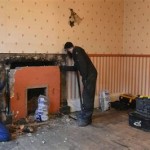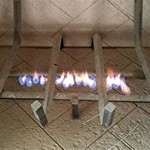Corner Fireplaces: A Gas-Fueled Solution for Space and Ambiance
Corner fireplaces, particularly those fueled by gas, present a compelling alternative to traditional fireplace designs. They offer a unique blend of space-saving efficiency and aesthetic appeal, making them a popular choice for homeowners looking to maximize room layout while enjoying the warmth and ambiance of a fire. This article will explore the advantages, considerations, and installation aspects of corner gas fireplaces, providing a comprehensive understanding of this heating and design option.
The primary advantage of a corner fireplace lies in its ability to fit seamlessly into areas where a traditional fireplace would be impractical. By utilizing a corner space, these installations free up valuable wall space, allowing for better furniture arrangement and traffic flow. This is especially beneficial in smaller rooms or open-concept living areas where maximizing space is crucial. Furthermore, the angled placement can create a focal point that draws the eye and adds architectural interest to the room.
Gas-fueled corner fireplaces offer several benefits compared to their wood-burning counterparts. Convenience ranks high among these advantages. With a gas fireplace, there is no need to gather, store, and load wood. Starting and stopping the fire is typically a simple process involving the flick of a switch or the press of a button on a remote control. This ease of use makes gas fireplaces a practical option for individuals who want the ambiance of a fire without the associated labor and mess.
Another significant benefit of gas fireplaces is their efficiency. Modern gas fireplaces boast high energy efficiency ratings, meaning they convert a large percentage of the fuel into usable heat. This can translate into lower heating costs compared to traditional wood-burning fireplaces, which often lose a significant amount of heat up the chimney. Furthermore, gas fireplaces produce fewer emissions than wood-burning fireplaces, contributing to cleaner air quality.
Space Optimization and Design Flexibility
Corner fireplaces excel in situations where space is a premium. Traditional fireplaces require a substantial amount of wall space, which can limit furniture placement and room design. Corner models, however, nestle neatly into the intersection of two walls, effectively utilizing an often-underutilized area. This allows for more flexible furniture arrangements and can create a sense of spaciousness, even in smaller rooms. For instance, in a living room, a corner fireplace can free up wall space for a large television or a bookshelf, optimizing the room's functionality and aesthetics.
The design flexibility of corner gas fireplaces is another key advantage. They are available in a wide range of styles, from traditional to contemporary, to complement various interior design schemes. Options include various facing materials such as brick, stone, tile, and metal, allowing homeowners to customize the fireplace to match their personal taste and the overall aesthetic of the room. Furthermore, different firebox designs, including log sets, glass media, and contemporary ribbon flames, offer further customization options, enhancing the visual appeal of the fireplace.
Beyond their space-saving and design benefits, corner fireplaces can also contribute to improved room acoustics. The angled placement of the fireplace can help to diffuse sound waves, reducing echoes and improving the overall sound quality of the room. This is particularly beneficial in rooms with hard surfaces, such as tile or hardwood floors, where sound can easily bounce and create an echo effect.
Gas Fireplace Efficiency and Safety
Gas fireplaces are significantly more energy-efficient than traditional wood-burning fireplaces. Modern gas fireplaces can have efficiency ratings as high as 80% or more, meaning that a large percentage of the gas burned is converted into usable heat for the home. In contrast, traditional wood-burning fireplaces often have efficiency ratings below 20%, with much of the heat escaping up the chimney. This higher efficiency translates into lower heating costs for homeowners, making gas fireplaces a more economical option in the long run.
In addition to their efficiency, gas fireplaces are also considered safer than wood-burning fireplaces. Gas fireplaces are typically equipped with safety features such as oxygen depletion sensors (ODS), which automatically shut off the gas supply if the oxygen level in the room drops to an unsafe level. This helps to prevent carbon monoxide poisoning, a serious risk associated with wood-burning fireplaces. Furthermore, gas fireplaces do not produce sparks or embers, reducing the risk of accidental fires.
The convenience of gas fireplaces also contributes to their safety. Because they are easy to start and stop, homeowners are less likely to leave a gas fireplace unattended or to attempt to add fuel while the fire is still burning. This reduces the risk of accidents and injuries associated with improper use of the fireplace. Regular inspection and maintenance by a qualified technician are still essential to ensure safe and efficient operation.
Installation Considerations and Requirements
The installation of a corner gas fireplace involves several key considerations. First and foremost, it's crucial to ensure that the fireplace is installed by a qualified and licensed professional. This ensures that the installation complies with all local building codes and safety regulations. Improper installation can lead to gas leaks, carbon monoxide poisoning, or other hazards.
One of the most important considerations is the venting system. Gas fireplaces require a venting system to safely exhaust combustion gases to the outside. There are two main types of venting systems: direct vent and B-vent. Direct vent systems draw combustion air from outside and exhaust combustion gases directly to the outside, making them a highly efficient and safe option. B-vent systems, on the other hand, use air from inside the room for combustion and require a chimney or flue to exhaust the gases. The choice of venting system will depend on the specific fireplace model and the layout of the home.
Another critical consideration is the gas supply. A gas line must be run to the fireplace location to provide fuel. This work should be performed by a qualified plumber or gas fitter to ensure that the connection is safe and leak-free. The size of the gas line must be adequate to supply the fireplace with the required amount of gas. Furthermore, a shut-off valve should be installed near the fireplace to allow for easy shut-off in case of emergency.
Finally, consider the framing and finishing around the fireplace. The fireplace must be properly framed to provide adequate support and clearance from combustible materials. The finishing materials, such as brick, stone, or tile, should be installed according to the manufacturer's instructions and in compliance with local building codes. The finishing should also be aesthetically pleasing and complement the overall design of the room.
Choosing a corner gas fireplace requires careful planning and consideration of various factors, from space constraints and design preferences to safety and installation requirements. By understanding the benefits and limitations of this type of fireplace, homeowners can make an informed decision and create a cozy and inviting space in their homes.
Corner Gas Fireplaces Heatilator

The Corner Gas Fireplace A Great Way To Maximize Your Space

Corner Ventless Gas Fireplace Visualhunt

Discover The 61 Best Corner Fireplace Designs In 2024 Living Room Gas

Lx2 3 Sided Corner Gas Fireplace Natural The Center

Corner Fireplaces Modern Gas The Davinci Collection

110 Best Corner Gas Fireplace Ideas Design Remodel

Maximize Your Space With A Corner Gas Fireplace Aqua Rec S Fireside Hearth N Home

18 Corner Orno Gas Log Burning Kiva Fireplace Kit Capo Fireside

Chicago Corner 40re Designer Gas Fireplace Regency
Related Posts








